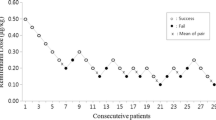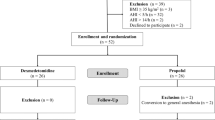Abstract
Background
We designed this study to investigate the effect of dexmedetomidine (1 μg/kg) pretreatment on the median effective dose (ED50) of propofol for facilitating successful laryngeal mask airway (LMA) insertion compared to propofol alone.
Methods
Forty patients were randomized to either the control group (n = 21) or the dexmedetomidine group (n = 19). After infusion of normal saline or dexmedetomidine 1 µg/kg over 10 min, 1 % lidocaine 0.5 mg/kg, followed by propofol 2.5 mg/kg was administered and the laryngeal mask airway was inserted without muscle relaxants. The ED50 of propofol for successful LMA insertion was determined by the modified Dixon’s up-and-down method. The ED50 and ED95 were also calculated using an isotonic regression method, based on the pooled adjacent-violators algorithm-adjusted response rate, and the confidential interval (CI) was estimated using a bootstrap approach.
Results
The ED50 of propofol for smooth insertion of the LMA was significantly higher in the control group than in the dexmedetomidine group (3.1 ± 0.4 vs 1.9 ± 0.3 mg/kg, P < 0.001). From isotonic regression analysis using a bootstrap approach, the ED50 and ED95 of propofol was 2.9 mg/kg (83 % CI 2.5–3.3 mg/kg) and 3.9 mg/kg (95 % CI 3.5–4.0 mg/kg) in the control group, and 1.8 mg/kg (83 % CI 1.8–2.1 mg/kg) and 2.4 mg/kg (95 % CI 2.0–2.5 mg/kg) in the dexmedetomidine groups, respectively. The apnea time was not significantly different between the two groups.
Conclusions
Pretreatment with dexmedetomidine 1 μg/kg could reduce the propofol requirement by 38 % for facilitating LMA insertion without prolonged respiratory depression and hemodynamic instability.



Similar content being viewed by others
References
Baik HJ, Kim JH, Lee CH. Laryngeal mask insertion during target-controlled infusion of propofol. J Clin Anesth. 2001;13:175–81.
Sıddik-Sayyid SM, Aouad MT, Taha SK, Daaboul DG, Deeb PG, Massouh FM, Muallem MR, Baraka AS. A comparison of sevoflurane-propofol versus sevoflurane or propofol for laryngeal mask airway insertion in adults. Anesth Analg. 2005;100:1204–9.
Goh PK, Chiu CL, Wang CY, Chan YK, Loo PL. Randomized double-blind comparison of ketamine-propofol, fentanyl-propofol and propofol-saline on hemodynamics and laryngeal mask airway insertion conditions. Anesth Intensive Care. 2005;33:223–8.
Tayler N, Kenny GNC. Requirements for target-controlled infusion of propofol to insert the laryngeal mask airway. Anaesthesia. 1998;53:222–6.
Kodaka M, Okamoto Y, Handa F, Kawasaki J, Miyao H. Relationship between fentanyl dose and predicted EC50 of propofol for laryngeal mask airway insertion. Br J Anaesth. 2004;92:238–41.
Park HJ, Lee JR, Kim CS, Kim SD, Kim HS. Remifentanil halves the EC50 of propofol for successful insertion of the laryngeal mask airway and laryngeal tube in pediatric patients. Anesth Analg. 2007;105:57–61.
Yazicioglu H, Muslu S, Yamak B, Erdemli O. Laryngeal mask airway insertion with remifentanill. Acta Anaesthesiol Belg. 2005;56:171–6.
Goyagi T, Tanaka M, Nishikawa T. Fentanyl decreases propofol requirement for laryngeal mask airway insertion. Acta Anaesthesiol Scand. 2003;47:771–4.
Hsu YW, Cortinez LI, Robertson KM, Keifer JC, Sum-Ping ST, Moretti EW, Young CC, Wright DR, Macleod DB, Somma J. Dexmedetomidine pharmacodynamics: Part I, Crossover comparison of the respiratory effects of dexmedetomidine and remifentanil in healthy volunteers. Anesthesiology. 2004;101:1066–76.
Dutta S, Karol MD, Cohen T, Jones RM, Mant T. Effect of dexmedetomidine on propofol requirements in healthy subjects. J Pharm Sci. 2001;90:172–81.
Uzümcügil F, Canbay O, Celebi N, Karagoz AH, Ozgen S. Comparison of dexmedetomidine-propofol vs. fentanyl-propofol for laryngeal mask insertion. Eur J Anaesthesiol. 2008;25:675–80.
Dixon WJ. Staircase bioassay: the up-and-down method. Neurosci Biobehav Rev. 1991;15:47–50.
Stylianou M, Flournoy N. Dose finding using the biased coin up-and-down design and isotonic regression. Biometrics. 2002;58:171–7.
Pace NL, Stylianou MP. Advances in and limitations of up-and-down methodology: a precis of clinical use, study design, and dose estimation in anesthesia research. Anesthesiology. 2007;107:144–52.
Ramaswamy AH, Shaikh SI. Comparison of dexmedetomidine-propofol versus fentanyl-propofol for insertion of laryngeal mask airway. J Anaesthesiol Clin Pharmacol. 2015;31:217–20.
Jang YE, Kim YC, Yoon HK, Jeon YT, Hwang JW, Kim E, Park HP. A randomized controlled trial of the effect of preoperative dexmedetomidine on the half maximal effective concentration of propofol for successful i-gel insertion without muscle relaxants. J Anesth. 2015;29:338–45.
Choi JB, Kwak HJ, Lee KC, Lee SR, Lee SY, Kim JY. Comparison of remifentanil EC50 for facilitating i-gel and laryngeal mask airway insertion with propofol anesthesia. J Anesth. 2016;30:377–83.
Choi JJ, Kim JY, Lee D, Chang YJ, Cho NR, Kwak HJ. Male patients require higher optimal effect-site concentrations of propofol during i-gel insertion with dexmedetomidine 0.5 μg/kg. BMC Anesthesiol. 2016;16:20.
Kwak HJ, Min SK, Yoo JY, Park KH, Kim JY. The median effective dose of dexmedetomidine for laryngeal mask airway insertion with propofol 2.0 mg/kg. Acta Anaesthesiol Scand. 2014;58:815–9.
Bloor BC, Ward DS, Belleville JP, Maze M. Effects of intravenous dexmedetomidine in humans. II. Hemodynamic changes. Anesthesiology. 1992;77:1134–42.
Kunisawa T, Nagata O, Nagashima M, Mitamura S, Ueno M, Suzuki A, Takahata O, Iwasaki H. Dexmedetomidine suppresses the decrease in blood pressure during anesthetic induction and blunts the cardiovascular response to tracheal intubation. J Clin Anesth. 2009;21:194–9.
Lee MP, Kua JS, Chiu WK. The use of remifentanil to facilitate the insertion of the laryngeal mask airway. Anesth Analg. 2001;93:359–62.
Yu AL, Critchley LA, Lee A, Gin T. Alfentanil dosage when inserting the classic laryngeal mask airway. Anesthesiology. 2006;105:684–8.
Wu X, Hang LH, Wang H, Shao DH, Xu YG, Cui W, Chen Z. Intranasally administered adjunctive dexmedetomidine reduces perioperative anesthetic requirements in general anesthesia. Yonsei Med J. 2016;57:998–1005.
Kim J, Kim WO, Kim HB, Kil HK. Adequate sedation with single-dose dexmedetomidine in patients undergoing transurethral resection of the prostate with spinal anaesthesia: a dose-response study by age group. BMC Anesthesiol. 2015;15:17.
Author information
Authors and Affiliations
Corresponding author
About this article
Cite this article
Yoo, J.Y., Kwak, H.J., Kim, Y.B. et al. The effect of dexmedetomidine pretreatment on the median effective bolus dose of propofol for facilitating laryngeal mask airway insertion. J Anesth 31, 11–17 (2017). https://doi.org/10.1007/s00540-016-2245-7
Received:
Accepted:
Published:
Issue Date:
DOI: https://doi.org/10.1007/s00540-016-2245-7




